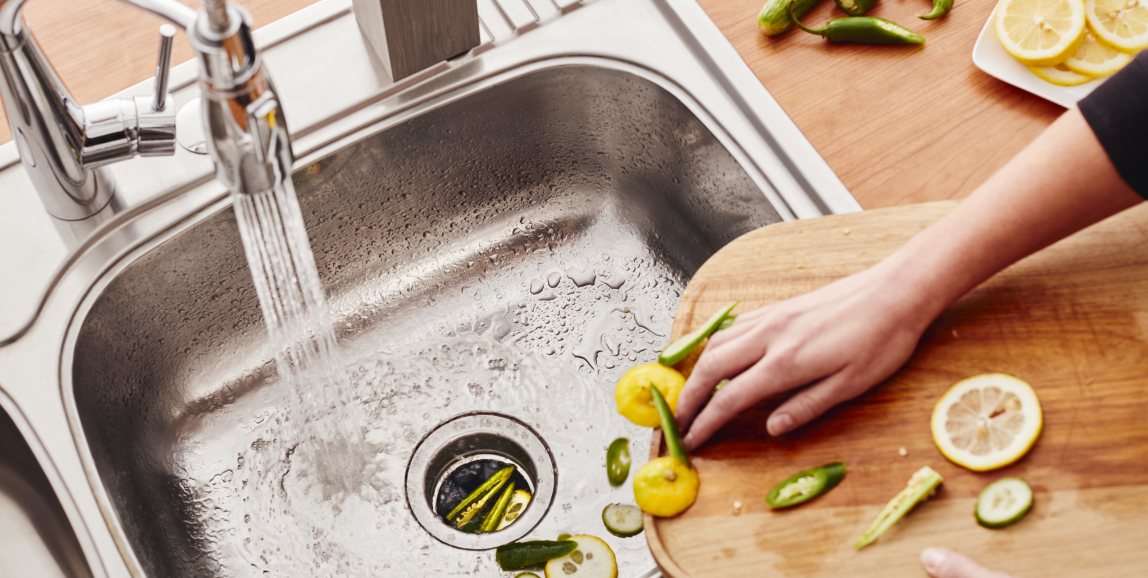Are you tired of standing in front of your double kitchen sink, water refusing to drain, and dishes piling up? If your kitchen lacks a garbage disposal, or even if it has one, this scenario can be frustrating and time-consuming.
You might find yourself wondering if Drano is the answer to your problems, but pause for a moment before you pour that bottle down the drain. With a few simple steps, you can tackle this issue head-on without relying on harsh chemicals.
Imagine the satisfaction of watching the water flow freely again, knowing you did it yourself. In this guide, we’ll explore effective methods to unclog your double kitchen sink, with or without a garbage disposal, and discuss whether using Drano is a wise choice. Get ready to regain control of your kitchen and transform that stagnant sink into a free-flowing, functional space once more.

Credit: www.reddit.com
Common Causes Of Clogs
Clogged kitchen sinks can disrupt your daily routine. Understanding the common causes helps prevent future blockages. A double kitchen sink without a garbage disposal often clogs due to various reasons. Knowing these causes can save time and effort.
Food Waste Accumulation
Food particles often go down the drain. Over time, they build up. Pasta, rice, and potato peels are frequent culprits. These expand with water, causing severe clogs. Use a sink strainer to catch these particles. Regularly clean the strainer to prevent buildup.
Grease Build-up
Pouring grease down the sink is a common mistake. Hot grease may seem harmless, but it solidifies. This creates a sticky barrier in your pipes. Other debris then sticks to the grease. Avoid pouring grease down the drain. Instead, let it cool and dispose of it in the trash.
Foreign Objects
Foreign objects can accidentally fall into the sink. Small utensils, rings, or even a piece of plastic can cause clogs. These items block water flow and trap other debris. Always be cautious when washing dishes. Check the sink for any fallen objects before running water.
Safety Precautions
Unclogging a double kitchen sink without a garbage disposal requires patience and care. Avoid using Drano in sinks with garbage disposals to prevent damage. Always wear gloves and ensure proper ventilation when dealing with chemicals.
Unclogging a double kitchen sink without a garbage disposal can be a daunting task, but with the right safety precautions, you can tackle the job confidently. Protecting yourself and ensuring a safe environment is crucial. Whether you’re using chemical solutions or natural methods, a few simple steps can prevent accidents and health hazards. Let’s dive into how you can safeguard yourself with some practical measures.
Protective Gear
Before you start unclogging, think about the gear you’ll need. Gloves are non-negotiable. They protect your skin from harsh chemicals and unpleasant residues.
Consider wearing goggles. Splashing chemicals can irritate or damage your eyes. Aprons or old clothing can shield your clothes from stains and spills.
Ventilation
Good ventilation is your ally in ensuring safety. Chemical cleaners often release fumes. Open windows and doors to allow fresh air to circulate. This reduces inhalation risks.
If your kitchen lacks windows, consider using a fan to disperse fumes. A well-ventilated area helps keep you safe and comfortable while you work.
Taking these precautions not only protects you but also creates a safer environment for everyone in your home. Have you ever experienced a mishap while fixing a clogged sink? Thinking ahead can prevent those unexpected surprises.
Drano Application Steps
Drano can be used to unclog a double kitchen sink without a garbage disposal. Pour Drano into the clogged sink, wait 15 minutes, and flush with hot water. Avoid using Drano in sinks with garbage disposals, as it can damage the disposal unit.
Unclogging a double kitchen sink without a garbage disposal can be tricky. Drano offers a chemical solution to clear the blockage. Follow these steps to use Drano effectively. Ensure safety and get your sink flowing again.
Choosing The Right Drano Product
Drano has various products for different clogs. Select one suitable for kitchen sinks. Read the label carefully. The product should be safe for your pipes. Choose a product specifically for tough clogs.
Preparing The Sink Area
Clear the sink of any dishes or debris. Wear gloves and goggles for protection. Ensure the area is well-ventilated. This helps avoid inhaling any fumes. Keep children and pets away from the area.
Pouring Drano Safely
Carefully open the Drano bottle. Pour the recommended amount into the sink drain. Avoid splashes by pouring slowly. Do not mix Drano with other chemicals. Follow the instructions on the label.
Allowing Time For Effect
Let Drano work for the specified time. Usually, it’s about 15 to 30 minutes. During this time, avoid using the sink. This allows the chemical to break down the clog. After the waiting period, flush with hot water. Check if the sink is draining properly. Repeat if necessary, but follow the instructions.

Credit: www.affresh.com
Alternative Methods
Drano isn’t suitable for sinks with garbage disposals, but alternative methods can tackle clogs effectively. Try a mix of baking soda and vinegar, followed by hot water to clear blockages. Use a plunger or plumber’s snake for stubborn clogs in double kitchen sinks.
If your double kitchen sink is clogged and you don’t have a garbage disposal, it might feel like a daunting task to clear it up. While commercial drain cleaners like Drano are tempting, they aren’t always the safest option for your pipes. Instead, there are several alternative methods you can try that are both effective and environmentally friendly. Let’s dive into some practical solutions you can implement right away.
Plunger Use
Using a plunger on a kitchen sink might seem unconventional, but it’s incredibly effective. Ensure that both sides of the sink are filled with a few inches of water. This helps create the necessary suction to dislodge the blockage.
Place the plunger over the drain and give it several firm pumps. You might need to repeat the process a few times. Have you ever felt the satisfaction of seeing the water finally swirling down the drain after a few vigorous pumps? It’s worth the effort.
Baking Soda And Vinegar
This classic household remedy is not only cost-effective but also gentle on your plumbing. Begin by pouring a pot of boiling water down the clogged drain. Then, add one cup of baking soda, followed by one cup of vinegar.
Cover the drain with a plug and wait for about 15 minutes. During this time, the chemical reaction between baking soda and vinegar works wonders in breaking down the clog. Finish by flushing the drain with another pot of boiling water. It’s surprising how these simple kitchen staples can perform magic on your stubborn sink clogs.
Manual Pipe Cleaning
Sometimes, manual intervention is necessary. This involves removing the P-trap under your sink, which often traps debris and food particles. Use a bucket to catch any water and unscrew the nuts connecting the pipes.
Carefully remove the P-trap and clean out any obstructions. Reattach the pipes securely before testing the drain. While it might seem intimidating, it’s a straightforward process that can save you a call to the plumber. Have you ever wondered how much gunk can accumulate in your pipes over time? The answer can be eye-opening.
By using these alternative methods, you can tackle the clog in your double kitchen sink without relying on harsh chemicals. Which method will you try first?
Preventative Measures
A double kitchen sink without a garbage disposal can clog easily. Preventative measures help keep it clear. Regular maintenance, proper waste disposal, and sink strainers can prevent clogs.
Regular Maintenance
Regular maintenance is key to a healthy sink. Clean your sink weekly with hot water. Hot water flushes away grease and food particles. Use baking soda and vinegar for stubborn dirt. This keeps pipes clean and clear.
Proper Waste Disposal
Proper waste disposal prevents clogs. Avoid pouring oil down the sink. Oil solidifies and blocks pipes. Dispose of coffee grounds in trash. They clump together and cause blockages. Scrape plates into the trash before washing.
Use Of Sink Strainers
Sink strainers catch food particles. They prevent debris from entering pipes. Use strainers to trap large pieces of food. Empty strainers regularly to avoid buildup. A clean strainer keeps your sink draining smoothly.

Credit: www.reddit.com
Frequently Asked Questions
How To Unclog A Double Kitchen Sink Without A Garbage Disposal?
Use a plunger to create suction in one sink, then repeat in the other. Pour baking soda and vinegar down the drains. Let it fizz for 15 minutes, then flush with hot water. If needed, use a plumber’s snake to clear stubborn clogs.
How To Unclog A Double-sided Kitchen Sink?
Use a plunger on one side, then the other. Pour baking soda and vinegar down the drain. Rinse with hot water. If clogged, use a plumber’s snake.
What Is The Strongest Thing To Unclog A Sink?
The strongest solution for unclogging a sink is a commercial drain cleaner with sodium hydroxide. It’s highly effective for dissolving blockages. Always follow instructions and use protective gear. Alternatively, a plumbing snake can manually remove stubborn clogs without chemicals. Ensure proper ventilation when using any chemical cleaner.
Can You Use Drain Cleaner In A Sink With A Garbage Disposal?
Yes, you can use drain cleaner in a sink with a garbage disposal. Ensure the cleaner is compatible with disposals. Use it sparingly to avoid damage. Follow the product instructions carefully for safety and effectiveness. Regular maintenance helps prevent clogs and keeps your disposal functioning well.
Can You Use Drano In A Sink With Garbage Disposal?
Yes, but ensure the disposal is turned off. Follow product instructions carefully.
Conclusion
Unclogging a double kitchen sink can be tricky. But, simple steps make it easy. Using Drano in sinks with garbage disposal is possible. Just follow the instructions carefully. Regular maintenance helps prevent clogs. Clean your sink often to avoid blockages.
Remember, natural solutions are also effective. Baking soda and vinegar can do wonders. Always wear gloves when handling chemicals. Protect your skin from harsh substances. Keep these tips in mind for a hassle-free kitchen experience. Maintaining a clear sink makes cooking and cleaning enjoyable.
Happy cooking!
